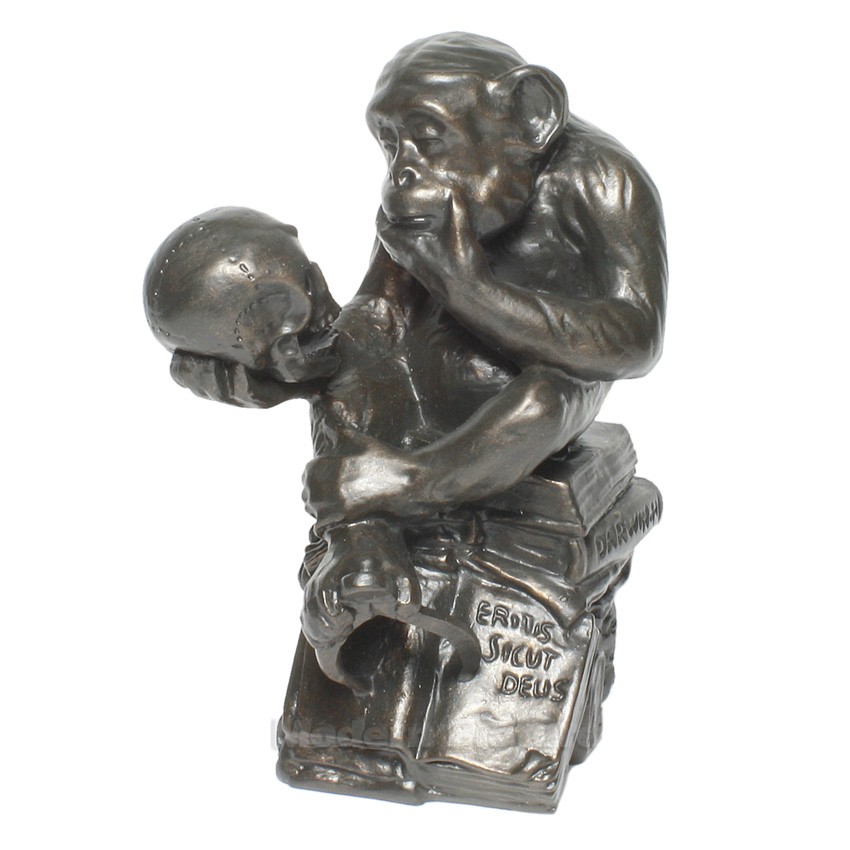Affe mit Schädel
Monkey with Skull (also a monkey skull looking ) is a 30 cm wide, allansichtige bronze sculpture by the German sculptor Hugo Rheinhold. The sculpture represents the final work of his sculpture studies in 1892 and is also his most famous work. It was first shown in 1893 at the Great Berlin Art Exhibition.
Description
The sculpture showing a chimpanzee sitting on a stack of books and looking at a human skull. He holds it in his right hand, the left is placed in a thinking- pose to his chin. The monkey looks curious, questioning and studying towards skull. He is completely absorbed in his view, however, seems to be in dialogue with the skull. A scene that The Thinker by Auguste Rodin also reminded of the events in the graveyard in Hamlet (5th Elevator, Scene 1 ) or to the bronze sculpture. In addition, the monkey with skull shows some elements from the research area. So clutching the chimpanzee with his right foot calipers, as it is known in the field of craniometry, and under the pile of books there is literature of the scientist Darwin. In addition to the scientific aspects are also represented religious and an open Bible to the viewer shows the quote " sicut deus Eritis ... " (Latin you will be like God ...) ( Gen 3:5 LUT). It is taken from the context of the Fall, in which the snake says this to Adam and Eve, before they both eat from the tree of knowledge, which leads to the expulsion from paradise. The Bible page appears torn in half, because the second part of the quote " ... bonum et malum scientes " (lat. ... Good and Evil ( knowing it ) ) is missing.
Detail: Pensive Pose
Detail: pile of books and research literature
Detail: Bible quote
Interpretation
The bronze sculpture monkey with skull is a symbol of science and of Darwinism and discussed the conflict with Christianity and the story of creation. The theories of Darwin on the evolution of polarized end of the 19th century society and heated tempers. One might assume that Rheinhold also was counterparty of Darwinism and his work is a satire on the theory of descent. For this, however, there is no evidence.
The stack of books represents the millennia acquired knowledge of the people, the measuring loop can be seen as a symbol for the research and the Bible quote representative of the church, which was repeatedly in conflict with the research and science. In addition, Rheinhold has chosen the chimpanzee as the main element of his sculpture, the closest relatives of humans at all. It shows the primates than humans equal or even superior to him. These elements can be an argument Rhine holds with the theory of descent suspect as the same time also in the work of Gabriel von Max ', for example in the painting Monkey before Skeleton, occurs.
The Bible quote " sicut deus Eritis " could represent the dichotomy between religion and evolutionary theory, but also a return to the monkey as a symbol of the devil and the Fall. Moreover, can the saying " You will be like God ( knowing good and evil ) " However, further interpretations. Rheinhold as an active pacifist possibly spoke an "early warning to science ethics " by trying to represent that man as God behaves, but the good and evil disregards - this part of the quotation is omitted Rheinhold - and eventually even it perishes. The skull as a vanitas motif supports this assumption. In addition, the monkey will eventually shown to be purer and more original form, the triumphs in the end over the people. This interpretation, however, is highly speculative.
Another vanitas motif is the association with the graveyard scene from Hamlet. Hamlet thinks the 5th lift, scene 1 about the meaning of life after, as he remembers the skull of the former court jester Yorick in his hands. This unique symbol of the transience of life is an additional indication of the powerlessness of man to life.
Motivation and role models
It is unclear what motives have role models and Hugo Rheinhold inspiration for his sculpture monkey with skull. However, it is often mentioned in connection with the Thinker by Rodin. Maybe Rheinhold was inspired by the theme of " setting apart ". However, employs the monkey, unlike the thinker, not with his own mind, but carefully studied a human skull. In addition, Rodin also applies not as inventor of this thinking- pose, but Michelangelo, the sculpture Il Pensiero created as a grave monument for Lorenzo II de ' Medici ( Duke of Urbino) early 16th century. In addition, the thinker has indeed created 1880-1882, but only in 1888 presented to the public. The plastic monkey with skull originated nearly parallel and in 1893 for the first time shown at the Great Berlin Art Exhibition. It can not say for sure whether Hugo Rheinhold actually has been inspired by the bronze sculpture of Rodin.
Michelangelo, grave monument of Lorenzo de ' Medici ( Duke of Urbino)
Provenance
The monkey with skull moved during the Great Berlin Art Exhibition, the attention of the Berlin art foundry Hermann Gladbeck & son on to that earned the original plastic still on site and secured the right of reproduction. The reproductions of the foundry have been sold around the world and reached both in private hands, as well as in museums and other public institutions. For example, not Lenin in 1922 this sculpture as a gift of the American industrialist and art collector Armand Hammer and placed it on his desk in the Kremlin, where she was seen in 1991.










